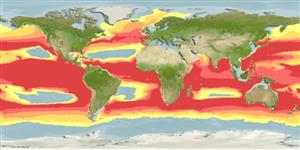>
Perciformes/Scorpaenoidei (Scorpionfishes) >
Setarchidae (Deep-sea bristly scorpionfishes)
Etymology: Ectreposebastes: Greek, ek = from, of, out + Greek, trepo = to turn, to rotate + Greek, sebastes = august, venerable (Ref. 45335).
More on author: Garman.
Environment: milieu / climate zone / depth range / distribution range
Écologie
marin bathypélagique; profondeur 150 - 2000 m (Ref. 559), usually 500 - 850 m (Ref. 36731). Deep-water
Atlantic, Indian and Pacific: in tropical and temperate waters. Eastern Atlantic: tropical western Africa. Western Atlantic: Canada (Ref. 5951) to Gulf of Mexico to Suriname.
Taille / Poids / Âge
Maturity: Lm ? range ? - ? cm
Max length : 18.0 cm SL mâle / non sexé; (Ref. 559); common length : 10.0 cm TL mâle / non sexé; (Ref. 4510)
Épines dorsales (Total) : 11 - 12; Rayons mous dorsaux (Total) : 9 - 11; Épines anales: 3; Rayons mous anaux: 5 - 7. Swim bladder lacking or rudimentary; bones poorly ossified; spine weak and usually broken during capture; scales thin and deciduous, and white body musculature soft and flabby (Ref. 11015). Lateral line more or less a continuous trough covered by thin membranous scales, usually lost during capture (Ref. 10482). Body is black in small specimens; maroon and black in adults (Ref. 11015). Buccal cavity black with patches of bright orange and red in life; pharyngeal teeth red or orange (Ref. 11015).
Among all scorpionfishes, it is structurally best adapted for mid-water existence (Ref. 11015). Benthopelagic (Ref. 58302). Feeds mainly on crustaceans, amphipods and sergestid shrimps (Ref. 28023). Anterolateral glandular grooves with venom gland at least in anal-fin spines (Ref. 57406).
Life cycle and mating behavior
Maturities | Reproduction | Spawnings | Egg(s) | Fecundities | Larves
Eschmeyer, W.N. and B.B. Collette, 1966. The scorpionfish subfamily Setarchinae, including the genus Ectreposebastes. Bull. Mar. Sci. 16(2):349-375. (Ref. 11015)
Statut dans la liste rouge de l'IUCN (Ref. 130435)
Utilisations par l'homme
Pêcheries: intérêt commercial mineur
Outils
Articles particuliers
Télécharger en XML
Sources Internet
Estimates based on models
Preferred temperature (Ref.
123201): 4.6 - 10.7, mean 7.1 °C (based on 831 cells).
Phylogenetic diversity index (Ref.
82804): PD
50 = 0.7578 [Uniqueness, from 0.5 = low to 2.0 = high].
Bayesian length-weight: a=0.01047 (0.00417 - 0.02629), b=3.04 (2.82 - 3.26), in cm total length, based on LWR estimates for this (Sub)family-body shape (Ref.
93245).
Niveau trophique (Ref.
69278): 3.1 ±0.30 se; based on food items.
Fishing Vulnerability (Ref.
59153): Low vulnerability (12 of 100).
